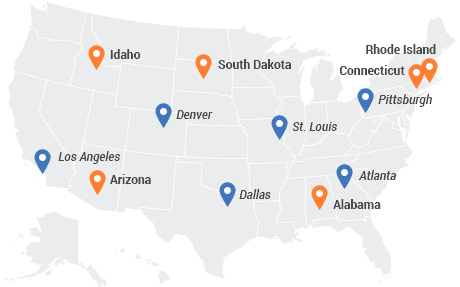From 2012 to 2022, the transportation sector will need to hire approximately 4.6 million workers to service our transportation system. [Source: Department of Transportation/Department of Labor, 2019]
The Associated General Contractors of America (AGC) conducted a survey of its members in 2015 to define their workforce needs. The survey found that more than 60 percent of construction firms across the country were struggling to fill open positions. A follow-up survey in 2018 showed the same trend.
| Occupation | AGC | BLS | BLS |
|---|---|---|---|
| % of contractors filling jobs |
% increase 2012-2022 |
Projected job needs | |
| Carpenters | 67% | 8.20% | 1,095,195 |
| Electricians | 60% | 8.90% | 729,263 |
| Equipment Operators | 64% | 12.30% | 81,155 |
| Cement Masons | 66% | 28.60% | 906,045 |
| Pipefitter/Plumber | 66% | 21.40% | 424,967 |
| Construction Laborers | 60% | 27.00% | 707,437 |
| Painters | 56% | 28.00% | 100,144 |
| Ironworkers/Welders | 62% | 15.10% | 171,507 |
| Mechanics | 55% | 10.50% | 1,451,233 |
Something needs to be done nationwide to fill these workforce gaps. America's transportation system - the lifeline of our freedom and economy - depends on it.
The workers that are available to fill these jobs are often unaware of the economic and career opportunities that a highway construction job can bring.
A webinar hosted by American Road and Transportation Builders Association (ARTBA), which was broadcast on April 5, 2019, provides an overview of the Highway Construction Workforce Partnership (HCWP), a joint effort of transportation construction industry leaders and local, state, and federal government agencies.
To help solve the highway workforce shortage, partners from government and industry came together and designed a 2-year national pilot to discover possible solutions. Their task: Develop a new model to identify, train, and place workers into highway construction jobs.
The partners selected 12 locations for the pilot - six cities and six states - that tried new strategies and techniques for filling vacant construction jobs. FHWA learned from their experiences and captured their successes and challenges in a "playbook" that you can use to build the highway construction workforce in your area.

The playbook is a short, actionable document. It provides useful practices - "plays" - gleaned from the pilots that can help you form a working group to identify, train, and place highway construction workers. The playbook includes:
The strategies and tactics in the playbook represent experiences from across the country. It is likely that you will find some of the challenges they address to be familiar to your own. Furthermore, the plays can be used in part or in whole, in any combination and in any order, to tailor solutions to your specific needs.
The playbook is just a first step. To solve the workforce problem long term will require a lasting effort that remains focused and continues to improve. To help, we have formed the Highway Construction Workforce Partnership (HCWP), a collaboration of the national partners to provide the ongoing knowledge, resources, and technical support that you may need with your local efforts.
Through the HCWP, FHWA is available to provide direct technical support to help you get started and move forward. We can answer questions about your workforce challenges, point you toward a specific resource, or even connect you with others across the country. FHWA will also host peer exchanges to provide opportunities for you to interact with people from other locations, learn from them, and share your ideas.
We hope you'll join us. To start, you can join our Roads To Your Future communication network or, if you're ready, ask a question or request technical assistance.